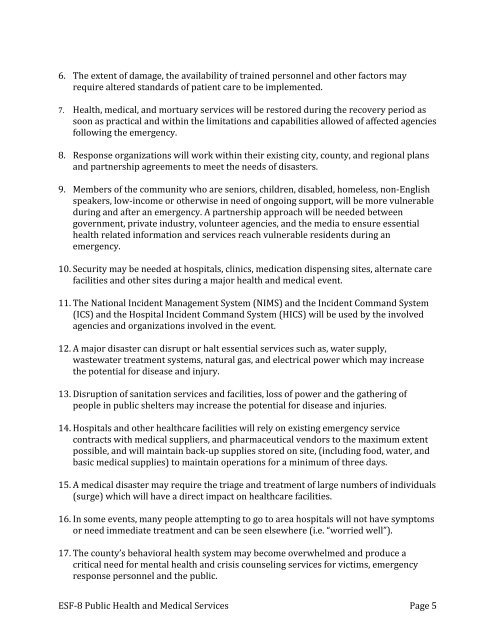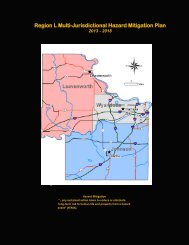ESF-8 Public Health & Medical Services - jocoem
ESF-8 Public Health & Medical Services - jocoem
ESF-8 Public Health & Medical Services - jocoem
You also want an ePaper? Increase the reach of your titles
YUMPU automatically turns print PDFs into web optimized ePapers that Google loves.
6. The extent of damage, the availability of trained personnel and other factors mayrequire altered standards of patient care to be implemented.7. <strong>Health</strong>, medical, and mortuary services will be restored during the recovery period assoon as practical and within the limitations and capabilities allowed of affected agenciesfollowing the emergency.8. Response organizations will work within their existing city, county, and regional plansand partnership agreements to meet the needs of disasters.9. Members of the community who are seniors, children, disabled, homeless, non‐Englishspeakers, low‐income or otherwise in need of ongoing support, will be more vulnerableduring and after an emergency. A partnership approach will be needed betweengovernment, private industry, volunteer agencies, and the media to ensure essentialhealth related information and services reach vulnerable residents during anemergency.10. Security may be needed at hospitals, clinics, medication dispensing sites, alternate carefacilities and other sites during a major health and medical event.11. The National Incident Management System (NIMS) and the Incident Command System(ICS) and the Hospital Incident Command System (HICS) will be used by the involvedagencies and organizations involved in the event.12. A major disaster can disrupt or halt essential services such as, water supply,wastewater treatment systems, natural gas, and electrical power which may increasethe potential for disease and injury.13. Disruption of sanitation services and facilities, loss of power and the gathering ofpeople in public shelters may increase the potential for disease and injuries.14. Hospitals and other healthcare facilities will rely on existing emergency servicecontracts with medical suppliers, and pharmaceutical vendors to the maximum extentpossible, and will maintain back‐up supplies stored on site, (including food, water, andbasic medical supplies) to maintain operations for a minimum of three days.15. A medical disaster may require the triage and treatment of large numbers of individuals(surge) which will have a direct impact on healthcare facilities.16. In some events, many people attempting to go to area hospitals will not have symptomsor need immediate treatment and can be seen elsewhere (i.e. “worried well”).17. The county’s behavioral health system may become overwhelmed and produce acritical need for mental health and crisis counseling services for victims, emergencyresponse personnel and the public.<strong>ESF</strong>‐8 <strong>Public</strong> <strong>Health</strong> and <strong>Medical</strong> <strong>Services</strong> Page 5









